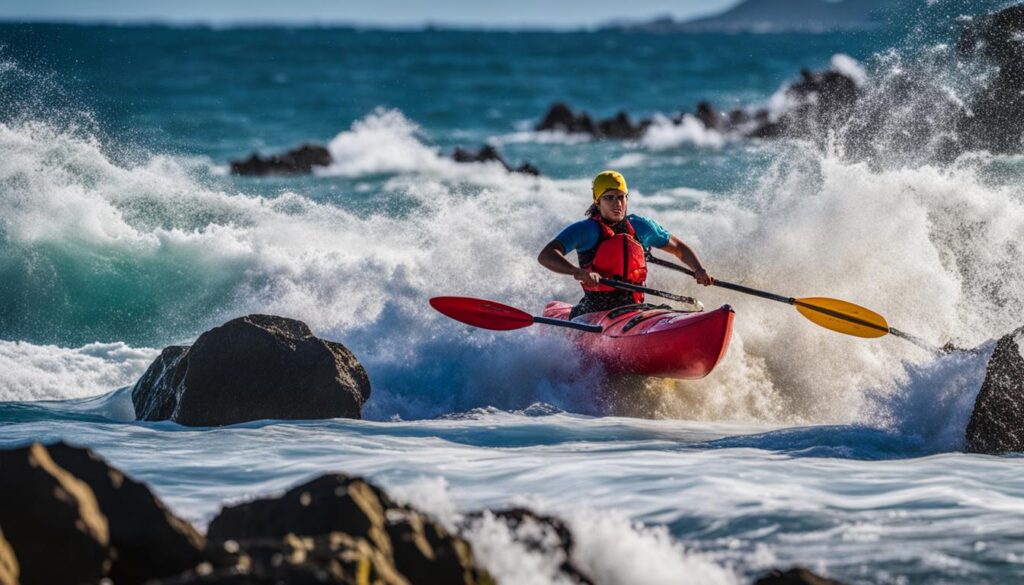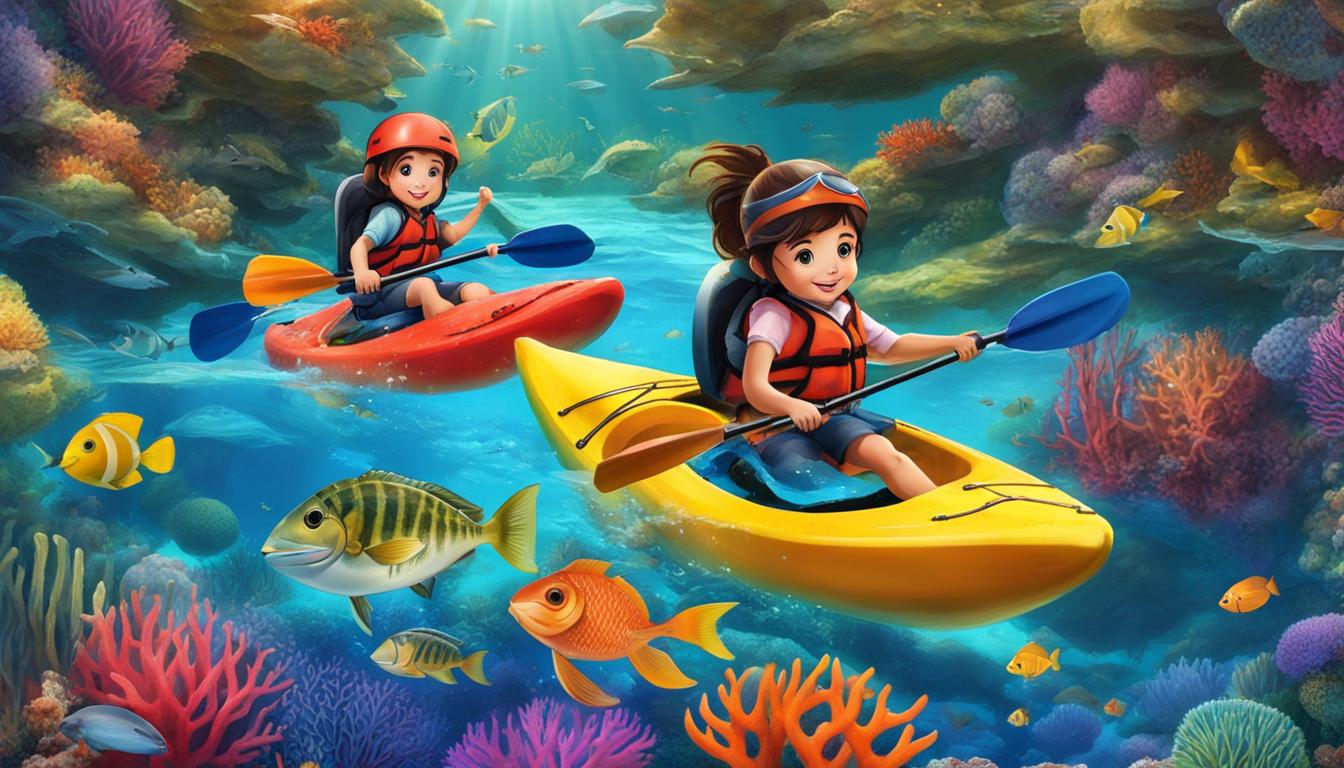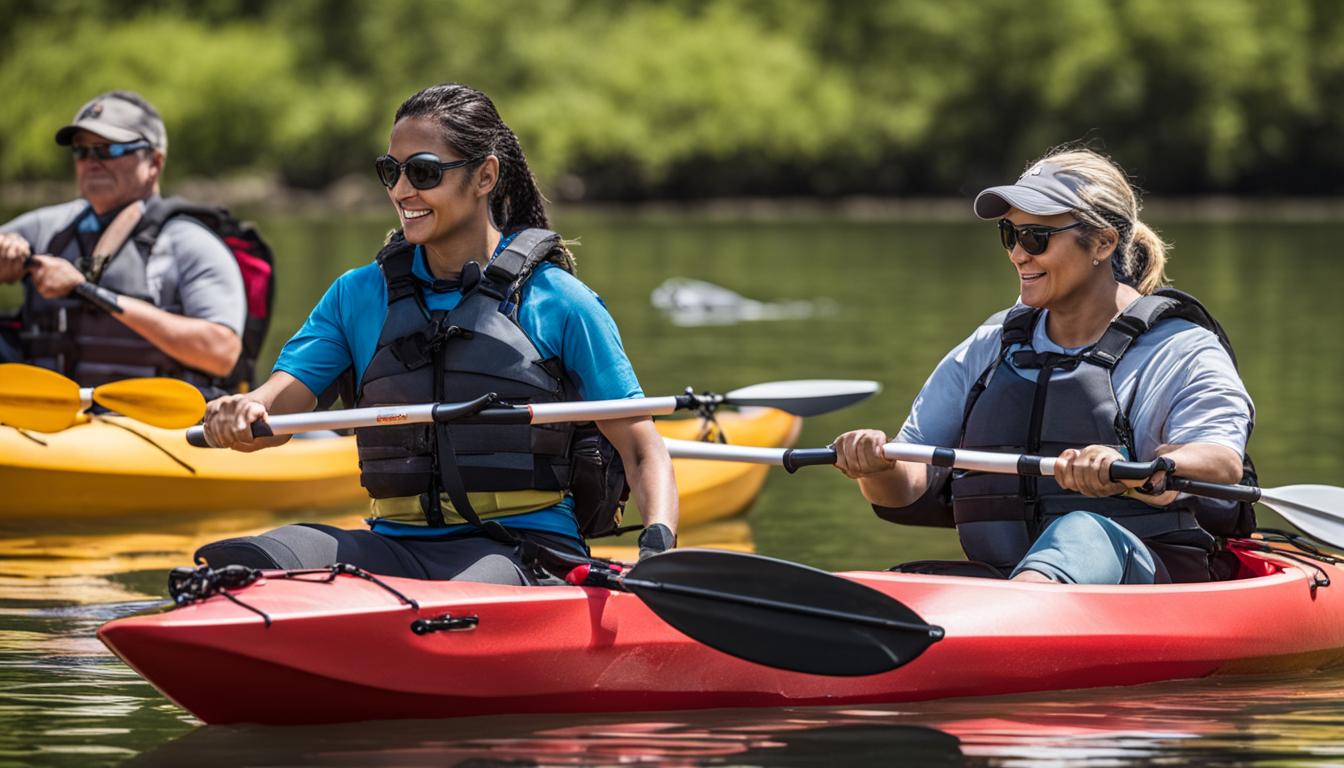Are you looking for an exciting and educational way to teach kids about aquatic life and instill a love for ocean preservation? Look no further than kids’ kayaking! By combining the thrill of kayaking with the importance of marine conservation, you can inspire the next generation to care for our oceans and the creatures that call it home.
Janaira Quigley, executive director of Ocean Connectors, believes in the power of connecting children with the coastal ecosystem. Through fun and educational field trips, Ocean Connectors aims to bring underserved coastal communities closer to their environment. By experiencing the beauty of the coast and its wildlife, children are inspired to protect and preserve it for future generations.
Key Takeaways:
- Teaching marine conservation through kids’ kayaking can create a love and appreciation for the ocean.
- Introducing children to the coastal ecosystem through kayaking helps them understand the importance of protecting aquatic life.
- Kayaking can be a fun and educational activity that fosters environmental stewardship in kids.
- By involving kids in planning kayaking trips and talking to them about the adventures they’ll have on the water, parents can spark their interest.
- Safety is paramount when kayaking with kids, including wearing proper life vests and choosing the right location.
Getting Kids Interested in Kayaking and Marine Conservation
To ignite curiosity and inspire a love for kayaking and marine conservation in children, it’s essential to engage them in exciting and educational activities that capture their imagination. By introducing kids to the wonders of kayaking and the importance of marine ecology, parents can instill a sense of environmental stewardship early on.
Start the journey by having conversations with your kids about the adventures they’ll experience on the water and the incredible marine life they’ll encounter. Share stories and facts about aquatic creatures, such as sea turtles, dolphins, and colorful fish, to pique their interest. Additionally, involve your children in the planning process, letting them choose the kayaking destination or help pack the gear. This involvement can foster a sense of ownership and excitement.
“The best way to get kids interested in kayaking and marine conservation is to immerse them in the experience from the start.”
Highlight the benefits of kayaking beyond the immediate thrill, emphasizing how it can foster a deep appreciation for nature. Explain that kayaking allows them to explore different habitats, observe wildlife up close, and develop a stronger connection to the natural world. By teaching children about cooperation, determination, and water safety through kayaking, parents can nurture their love for the environment and instill a sense of responsibility for its preservation.
Benefits of Kayaking for Children
Kayaking offers numerous benefits for children, both physically and mentally. Here are some key advantages:
- Enhances physical fitness and coordination
- Promotes mental well-being and reduces stress
- Develops problem-solving skills and adaptability
- Encourages teamwork and cooperation
- Teaches water safety and respect for the environment
By emphasizing these benefits, parents can lay the foundation for a lifelong passion for kayaking and marine conservation in their children.

Best Age to Start Kayaking with Kids
Kayaking is an excellent way to introduce children to the wonders of the water ecosystem and teach them about ocean conservation. The age at which children can start kayaking may vary depending on factors such as their maturity level, swimming skills, physical ability, and parent’s kayaking experience. It’s crucial to ensure that children are ready for the experience both mentally and physically.
For young children as young as 2 or 3 years old, they can safely sit in the center of a tandem kayak with an experienced adult. This allows them to feel secure and experience the joy of being out on the water while being closely supervised. Around the age of 5, children can begin paddling in the front seat of a double kayak, where they can actively participate in the kayaking experience. Alternatively, parents can consider getting a solo kayak that is the right size for their child to paddle comfortably.
By the age of seven, most children have developed the necessary coordination and strength to paddle their own kid-sized kayak independently. This is an opportune time to not only teach them about water ecosystems but also to instill a sense of responsibility and care for the environment. Exploring marine habitats through kayaking can ignite a passion for ocean conservation in children, allowing them to develop a lifelong connection with nature.
| Age | Recommended Activities |
|---|---|
| 2-3 years old | Sitting in the center of a tandem kayak with an experienced adult |
| Around 5 years old | Paddling in the front seat of a double kayak |
| 7 years old and above | Paddling their own kid-sized kayak independently |
As children grow and develop, their abilities and interests evolve. It’s important to assess their readiness and comfort level before engaging in kayaking activities. Starting at a young age allows children to build confidence and develop essential skills while fostering a deep appreciation for the water ecosystem.
Safety Tips for Kayaking with Kids
Kayaking with kids is a fantastic way to introduce them to the beauty of the water and the importance of marine conservation. However, safety should always be the top priority. Here are some essential safety tips to ensure a safe and enjoyable kayaking experience for you and your children.
1. Wear Proper Safety Gear
Before heading out on the water, make sure that all children under 13 years old are wearing a U.S. Coast Guard-approved wearable life vest or personal flotation device (PFD). It is important to choose the right size and fit for each child to ensure maximum safety. Additionally, wearing a properly fitting helmet is crucial, especially when kayaking in rocky or challenging environments.
2. Choose the Right Location
When kayaking with kids, it is essential to select a location with calm waters and minimal hazards. Avoid high currents, waves, or heavy boat traffic, as these can increase the risk of accidents. Research local lakes, calm rivers, or sheltered bays that are suitable for kayaking with children.
3. Teach Basic Kayak Rescue Techniques
Ensure that your kids are familiar with basic kayak rescue techniques, such as how to self-rescue if they accidentally capsize. Teaching them how to re-enter the kayak and safely paddle back to shore can empower them with the necessary skills to handle unexpected situations. Practice these rescue techniques in a controlled environment before venturing out on more challenging waters.
4. Maintain Appropriate Adult-to-Child Ratio
It is crucial to have a sufficient number of competent adults accompanying the children on the kayaking trip. The appropriate adult-to-child ratio will depend on the age and experience level of the children, as well as the difficulty of the kayaking location. Having more adults ensures that each child receives adequate supervision and assistance when needed.
5. Set Clear Rules and Have a Float Plan
Prior to the kayaking trip, establish clear rules and guidelines that the children must follow. This may include staying close to the group, not venturing too far from the designated route, and avoiding risky behaviors. Additionally, create a float plan that outlines the intended kayaking route, estimated time of return, and emergency contact information. Share this plan with a trusted individual on land.
By adhering to these safety tips, you can create a safe and enjoyable kayaking experience for you and your children. Remember, the goal is to foster a love for nature and marine conservation while ensuring the well-being of everyone involved in the adventure.
| Safety Tips for Kayaking with Kids |
|---|
| Wear Proper Safety Gear |
| Choose the Right Location |
| Teach Basic Kayak Rescue Techniques |
| Maintain Appropriate Adult-to-Child Ratio |
| Set Clear Rules and Have a Float Plan |
Kayaking in Surf and Rocks with Kids
For young kayakers who are passionate about the ocean and its preservation, kayaking in surf and rocks can be an exhilarating experience. It offers the opportunity to explore unique marine habitats and learn valuable lessons in marine habitat protection. However, it is crucial to prioritize safety and ensure that kids are adequately prepared for the challenges these environments present.
Before venturing into surf and rocky areas, it is essential for kids to be comfortable in moving water and have basic swimming skills. This will help them navigate the dynamic conditions they may encounter while kayaking. It is also important for competent adults to accompany kids on these excursions to provide guidance and ensure their safety. Additionally, equipping kids with the right gear is essential for their protection. This includes helmets, personal flotation devices (PFDs), and wetsuits to keep them safe and comfortable in the water.
Starting with calm waters and gradually progressing to more challenging conditions can help young kayakers develop their skills and confidence. It’s important to provide them with the necessary training and knowledge about navigating in surf and rocky areas. Educating them on tides, currents, and potential hazards like rocks and strong waves will enable them to make informed decisions and stay safe while exploring these unique habitats.
By engaging in kayaking adventures in surf and rocky environments, young kayakers can gain firsthand experience of the ocean’s beauty and fragility. These experiences can foster a deep sense of responsibility and commitment towards protecting marine habitats. It is through these immersive experiences that the next generation can become passionate advocates for ocean care and conservation.

Table: Essential Gear for Kayaking in Surf and Rocks
| Equipment | Description |
|---|---|
| Helmets | Protect the head from potential collisions with rocks or waves. |
| Personal Flotation Devices (PFDs) | Ensure buoyancy and keep the kayaker afloat in case of capsizing. |
| Wetsuits | Provide insulation and protection from cold water and abrasions. |
| Paddle Leashes | Prevent loss of paddles in strong waves or turbulent conditions. |
| Safety Whistle | Allows for audible signaling in case of emergencies. |
| Tow Lines | Can be used to tow or be towed in case assistance is needed. |
| Waterproof Communication Device | Enables communication with others in case of emergencies. |
Equipped with the right gear and knowledge, young kayakers can enjoy the thrill of navigating in surf and rocky areas while gaining a deeper understanding of marine habitats. These experiences can shape their perspectives and values, inspiring them to become dedicated stewards of the ocean.
Conclusion
Teaching marine conservation through kids’ kayaking is a fantastic way to educate and inspire the next generation about the importance of ocean preservation. By introducing children to the coastal ecosystem through fun and educational kayaking experiences, they can develop a deep love and appreciation for the ocean.
Through these kayaking activities, kids have the opportunity to learn valuable skills and knowledge about marine ecology. They can observe the beauty of the marine environment firsthand, witness the diverse aquatic life, and understand the importance of protecting and preserving it for future generations.
By following proper safety measures and gradually progressing from calm waters to more challenging environments, kayaking can be a safe and exciting activity for kids to explore and learn about marine awareness. It allows them to engage with the natural world, fostering a sense of responsibility and stewardship towards our oceans.
So, whether it’s a family kayaking adventure or an organized educational program, kayaking provides a perfect platform to teach kids about water ecosystems, instill a love for the ocean, and empower them to become future advocates for ocean conservation.
FAQ
What age is suitable for kids to start kayaking?
The age at which children can start kayaking depends on their maturity level, swimming skills, physical ability, and the parent’s kayaking experience.
How can parents get their kids interested in kayaking and marine conservation?
Parents can start by talking to their kids about the adventures they’ll have on the water and the wildlife they’ll encounter. Allowing kids to try sitting in a kayak and involving them in the planning process can also spark their interest. By highlighting the benefits of kayaking, such as fostering nature appreciation and teaching cooperation, determination, and water safety, parents can inspire their children to care about marine conservation.
What safety measures should be taken when kayaking with kids?
All children under 13 years old should wear a U.S. Coast Guard-approved wearable life vest or personal flotation device (PFD) when on a kayak. Choosing the right location with calm waters and avoiding high currents, waves, or heavy boat traffic is essential. Parents should also ensure that their kids know basic kayak rescue techniques, have a properly fitting helmet and PFD, and use a paddle that is the right size for them. Setting clear rules, having a float plan, and maintaining an appropriate adult-to-child ratio are also crucial for a safe and enjoyable kayaking experience.
Can kids kayak in surf and rocky areas?
Yes, kayaking in surf and rocks can be an exciting adventure for kids who love and respect the sea. However, it is important that kids are comfortable in moving water and have basic swimming skills. Competent adults should always accompany kids in these challenging environments, and kids should be properly outfitted with helmets, PFDs, and wetsuits. Starting with flat water and gradually progressing to more difficult conditions can help children develop their kayaking skills while staying safe.
Can kayaking help teach kids about marine conservation?
Yes, teaching marine conservation through kids’ kayaking is an effective way to inspire environmental stewardship in the next generation. By introducing children to the coastal ecosystem and involving them in fun and educational kayaking experiences, they can develop a love and appreciation for the ocean while learning valuable skills and knowledge about marine ecology.





